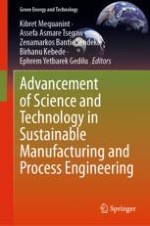2024 | Buch
Advancement of Science and Technology in Sustainable Manufacturing and Process Engineering
herausgegeben von: Kibret Mequanint, Assefa Asmare Tsegaw, Zenamarkos Bantie Sendekie, Birhanu Kebede, Ephrem Yetbarek Gedilu
Verlag: Springer Nature Switzerland
Buchreihe : Green Energy and Technology
